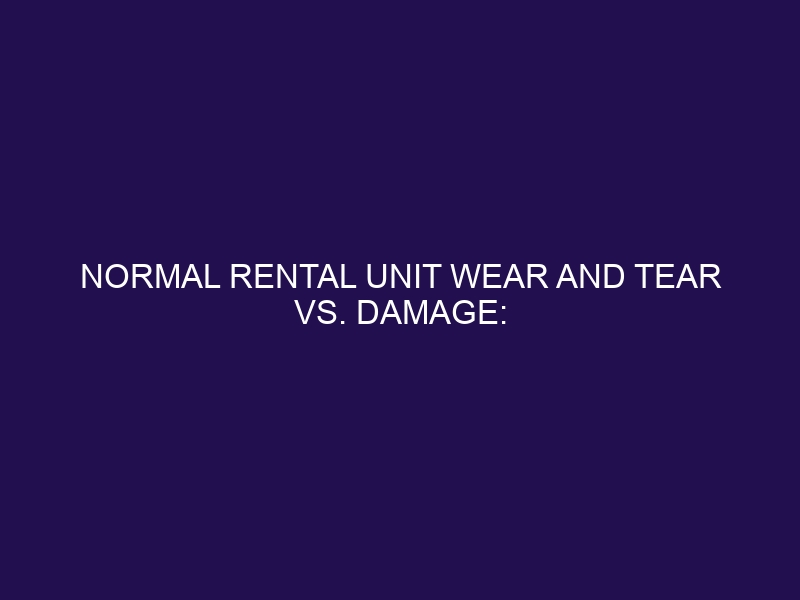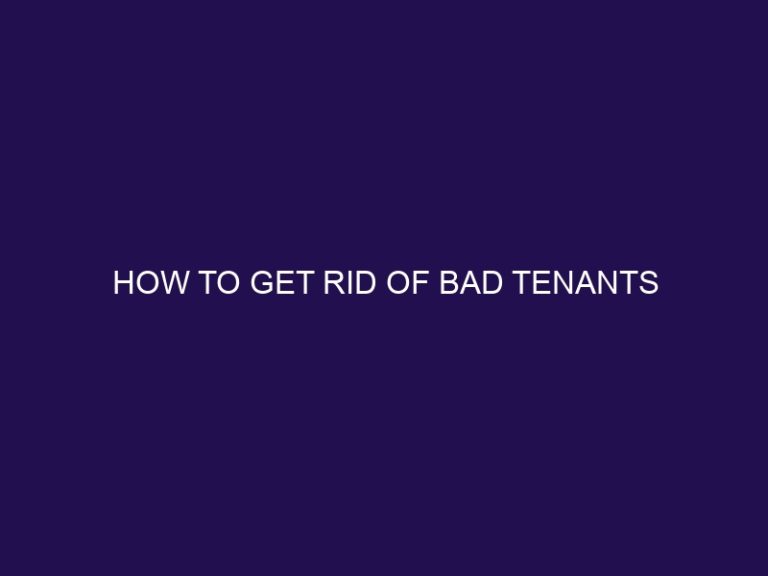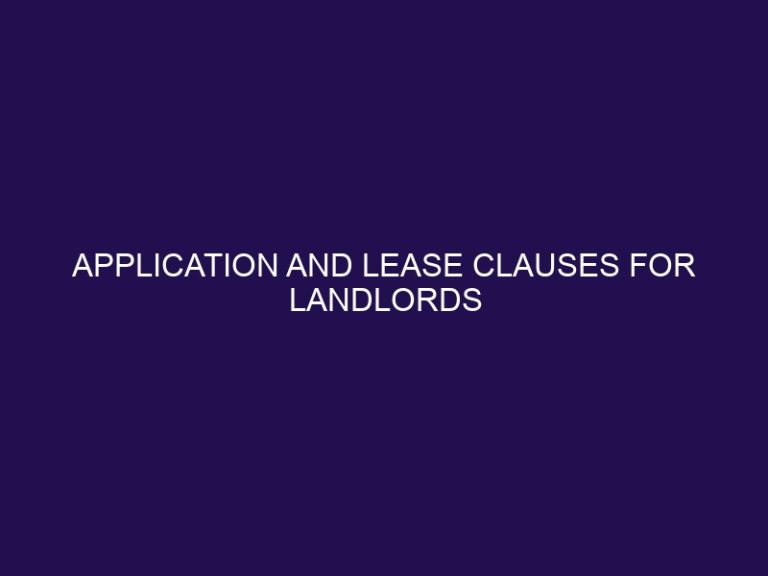Normal Rental Unit Wear And Tear Vs. Damage: What’s The Difference?
Normal wear and tear is a common occurrence in rental units, but it’s crucial to understand the difference between wear and tear and actual damage. This distinction is essential for both landlords and tenants to ensure a fair and smooth renting experience. According to the American Apartment Owners Association, wear and tear refers to the gradual deterioration of a rental unit that occurs naturally over time due to normal use, whereas damage is any harm caused by tenants to the property that goes beyond normal wear and tear.
Distinguishing between wear and tear and damage can sometimes be challenging. Wear and tear typically includes normal aging of appliances and fixtures, gradual fading or discoloration of walls and floors, and minor scuffs and scratches. On the other hand, rental unit damage may include intentional or negligent acts by tenants, significant holes, tears, or stains, and broken or damaged fixtures and appliances.
In terms of responsibilities, it’s generally the landlord’s duty to handle wear and tear, as it is considered a part of regular maintenance. Tenants, on the other hand, are responsible for any damage they cause beyond normal wear and tear. Proper documentation and assessment of the rental unit’s condition before and after occupancy are crucial. Move-in and move-out inspections, along with photographic evidence or video documentation, can provide a clear record of the unit’s condition at different stages.
In case of disagreement over wear and tear vs. damage, communication and understanding between the landlord and tenant are essential. It’s recommended to refer to the lease agreement, review the documented evidence, and if needed, seek mediation or legal advice to resolve any disputes effectively.
By understanding the difference between wear and tear and damage and following proper documentation procedures, both landlords and tenants can ensure a fair and transparent rental experience.
Understanding Rental Unit Wear and Tear
Rental unit wear and tear is of utmost importance for both landlords and tenants. It is crucial to comprehend the concept and significance of wear and tear, which pertains to the natural decline of a rental unit over time as a result of normal usage. This encompasses minor scuffs on the walls, worn-out carpets, or fading paint. When evaluating the condition of a rental unit, landlords should anticipate and consider wear and tear. It is essential to differentiate between wear and tear and tenant damage, such as wall holes or broken appliances. This differentiation aids landlords in determining the appropriate responsibility for repairs and ensures a just and transparent rental process for all parties involved.
Understanding Rental Unit Damage
Are you aware of the key differences between wear and tear and actual damage in a rental unit? In this section, we’ll unravel the intricacies of rental unit damage, helping you distinguish between these two situations. Get ready to discover valuable insights that will empower you to navigate rental agreements with confidence, understanding the nuanced factors that determine whether a situation falls under wear and tear or actual damage. So, let’s dive in and gain a deeper understanding of rental unit damage!
Distinguishing between Wear and Tear and Damage
Distinguishing between wear and tear and damage in a rental unit is crucial for both landlords and tenants. Wear and tear, which refers to the natural deterioration that happens over time due to regular use and aging, must be differentiated from damage. Wear and tear includes minor scuffs, fading or discoloration, and normal wear on appliances. On the other hand, damage is the result of intentional or negligent actions by tenants, leading to significant holes, tears, or stains, as well as broken fixtures and appliances. To distinguish between these two, factors such as the extent of the issue and its impact on the unit’s functionality or safety should be taken into account. Proper documentation and effective communication between landlords and tenants play a crucial role in settling any disputes.
Common Examples of Wear and Tear
When it comes to renting a unit, understanding the difference between normal wear and tear and actual damage is essential. In this section, we’ll explore common examples of wear and tear that landlords and tenants often encounter. From the gradual aging of appliances and fixtures to minor scuffs and scratches on walls and floors, we’ll shed light on what to expect in terms of normal wear and tear in a rental unit. So, let’s dive in and gain a better understanding of these everyday occurrences in the rental world.
Normal Aging of Appliances and Fixtures
- The normal aging of appliances and fixtures is a natural process that occurs over time due to regular wear and tear.
- Examples of normal aging include appliances and fixtures becoming less efficient and showing signs of wear, while surfaces gradually lose their original shine.
- While regular maintenance and cleaning can help prolong the lifespan of appliances and fixtures, it is inevitable that they will age.
- It is generally the responsibility of landlords to replace appliances and fixtures that have reached the end of their useful life due to normal aging.
To minimize the impact of normal aging, landlords can consider:
- Investing in high-quality appliances and fixtures that are built to last.
- Regularly inspecting and maintaining appliances to identify and address any issues early on.
- Providing tenants with guidelines for proper use and care of appliances and fixtures.
Gradual Fading or Discoloration of Walls and Floors
Gradual fading or discoloration of walls and floors is a common example of wear and tear in rental units. Over time, exposure to sunlight, cleaning agents, and foot traffic can cause paint or flooring to lose their original color. This natural aging process is expected and does not constitute damage. Landlords are typically responsible for addressing gradual fading or discoloration of walls and floors, including repainting or replacing flooring when necessary. Excessive or intentional damage, such as large stains or intentional paint stripping, is the tenant’s responsibility. It’s important to document and assess the condition of walls and floors during move-in and move-out inspections to avoid disputes.
Fun fact: Did you know that different flooring materials have varying levels of resistance to fading and discoloration?
Minor Scuffs and Scratches
- Minor scuffs and scratches are common examples of wear and tear in rental units. These minor imperfections can occur over time due to regular use and are considered normal.
- Landlords are typically responsible for addressing minor scuffs and scratches in rental units. They should perform regular inspections and touch-up any minor scuffs or scratches as part of their maintenance routine.
- Tenants can also be proactive and address minor scuffs and scratches themselves by using touch-up paint or markers that match the color of the walls or furniture. It is their responsibility to take care of these minor issues.
- Communication plays a crucial role in addressing wear and tear. Tenants should communicate with landlords about any noticeable wear and tear upon moving in and moving out. This ensures that everyone is aware of the condition of the unit and can take appropriate measures.
Common Examples of Rental Unit Damage
When it comes to the condition of a rental unit, distinguishing between normal wear and tear and actual damage can sometimes be a challenge. In this section, we will explore some common examples of rental unit damage that landlords often encounter. From intentional or negligent acts by tenants to significant holes, tears, or stains, and broken or damaged fixtures and appliances, we’ll shed light on these issues and help you understand the key differences. So, buckle up and get ready to delve into the world of rental unit damage!
Intentional or Negligent Acts by Tenants
Intentional or negligent acts by tenants can result in significant damage to rental units, leading to financial consequences for both tenants and landlords. Examples of such acts encompass acts of vandalism, unauthorized modifications, and a failure to promptly report and address damages. It is imperative for landlords to clearly establish the responsibilities of tenants regarding the preservation and upkeep of the rental unit. Tenants must comprehend that they bear responsibility for any harm caused by their actions or lack of maintenance. To prevent conflicts, it is crucial to diligently document and conduct regular inspections. Extra tip: Landlords have the opportunity to inform tenants about proper care and maintenance measures to mitigate the likelihood of intentional or negligent damage.
Significant Holes, Tears, or Stains
Significant holes, tears, or stains in a rental unit are considered examples of damage rather than normal wear and tear. Here are some instances of such damage:
- Holes in walls or doors from nails or screws
- Tears or rips in carpets or upholstery
- Stains on carpets, furniture, or countertops
- Burn marks on surfaces or appliances
It is the tenant’s responsibility to repair or pay for the damage. Landlords can deduct the cost of repairs from the security deposit. In a real-life story, a tenant accidentally spilled red wine on the carpet, causing a significant stain or stains. The landlord assessed the damage and deducted the cost of carpet replacement from the security deposit.
Broken or Damaged Fixtures and Appliances
When it comes to rental units, broken or damaged fixtures and appliances can be a common issue. Here are some things to consider:
- Check the condition of fixtures and appliances before moving in to note any existing damage.
- Report any new damage promptly to your landlord to avoid being held responsible.
- If you caused the damage, inform your landlord and discuss possible solutions.
- Landlords should ensure fixtures and appliances are in proper working condition before a new tenant moves in.
- Regular maintenance and inspections can help identify and address potential issues early on.
Landlord’s Responsibilities for Wear and Tear
As a landlord, it is crucial to understand your responsibilities when it comes to wear and tear in a rental unit. The landlord’s responsibilities for wear and tear include the following key things to consider:
1. Regular maintenance: It is your responsibility as a landlord to ensure that the rental unit is kept in good condition through regular maintenance and repairs.
2. Aging and normal use: Wear and tear are natural and expected over time due to aging and regular use. As a landlord, you should be aware that faded paint, worn carpet, or small scuffs on walls are examples of wear and tear.
3. Tenant communication: Maintaining open communication with tenants regarding any maintenance needs or repairs is essential. As a landlord, promptly addressing their concerns can prevent further damage to the rental unit.
Remember, maintaining the rental unit’s condition is not only your responsibility but also helps in attracting and retaining tenants, ultimately benefiting both parties.
Pro-tip: To handle any disputes regarding wear and tear effectively, conduct regular inspections and keep detailed records of the unit’s condition before and after each tenancy.
Tenant’s Responsibilities for Damage
When renting a unit, it is important for tenants to be aware of their responsibilities for damage. Tenant’s Responsibilities for Damage Here are some key things to keep in mind:
- Report any damages: Tenants should promptly report any damages to the landlord or property management to avoid further issues.
- Repair costs: Depending on the lease agreement, tenants may be responsible for covering the costs of repairing any damages caused by their negligence or misuse.
- Avoidance of intentional damage: Tenants should refrain from intentionally damaging the rental unit, as this can result in significant costs and legal consequences.
- Normal wear and tear: It is important to understand the difference between normal wear and tear and damages that require repair. Normal wear and tear refers to the expected deterioration that occurs over time due to ordinary use.
Pro-tip: Take photos or videos of the rental unit before moving in and after moving out to have documentation of the unit’s condition, helping to avoid disputes over damages.
How to Document and Assess Rental Unit Conditions
When it comes to rental units, knowing the difference between normal wear and tear and actual damage is vital. In this section, we will dive into how to document and assess the conditions of a rental unit. We’ll explore the importance of move-in and move-out inspections, as well as the value of photographic evidence or video documentation. By the end, you’ll be equipped with the knowledge you need to protect yourself and your investment. Let’s get started!
Move-In and Move-Out Inspections
-
Before conducting move-in inspections:
-
Initiate a walk-through of the rental unit with the tenant, carefully noting any pre-existing damage or signs of wear and tear.
-
Prepare a detailed written report encompassing all aspects of the inspection.
-
Support the findings with visual evidence by capturing photographs or videos of the unit.
-
-
During move-out inspections:
-
Perform a final assessment alongside the tenant to identify any new damages.
-
Refer to the initial inspection report for a thorough comparison.
-
Similarly, document any alterations and supplement the report with visual evidence.
-
-
After completing move-out inspections:
-
Compare the condition after move-out with the original move-in inspection report.
-
Hold the tenant responsible for any excessive damage beyond normal wear and tear.
-
Return the security deposit while deducting the necessary costs for repairs or cleaning.
-
Remember, conducting clear and comprehensive move-in and move-out inspections is vital in safeguarding the interests of both landlords and tenants. Effective communication and transparency serve as the pillars of this process.
Photographic Evidence or Video Documentation
When it comes to documenting rental unit conditions, incorporating photographic evidence or video documentation can be extremely helpful. Here are some reasons why it is important and how it can benefit both landlords and tenants:
- Accuracy: Photos or videos provide an accurate depiction of the rental unit’s condition at a specific point in time.
- Proof: They serve as proof of the condition of the property before and after a tenant’s occupancy, helping to resolve any disputes regarding damage or wear and tear.
- Clarity: They capture details that may be difficult to describe in writing, such as the extent of any damages or the quality of the fixtures and appliances.
- Convenience: Photographic evidence or video documentation can be easily stored and accessed digitally, making it convenient for both landlords and tenants during inspections or legal proceedings.
By utilizing photographic evidence or video documentation, both landlords and tenants can protect their interests and ensure a fair assessment of the rental unit’s condition.
What to Do If There is Disagreement over Wear and Tear vs. Damage?
What to Do If There is Disagreement over Wear and Tear vs. Damage?
When there is a disagreement over wear and tear versus damage in a rental unit, it is important to take the following steps to resolve the issue:
- Document: Take thorough photos and notes of the condition of the rental unit before and after the tenancy.
- Review the lease: Refer to the lease agreement to understand the landlord’s definition of wear and tear and damage.
- Communicate: Discuss the issue with the landlord or property manager and provide evidence to support your claim.
- Mediation: If the disagreement persists, consider involving a neutral third party, such as a mediator or arbitrator, to help reach a resolution.
- Legal recourse: If all else fails, consult with a lawyer to understand your rights and options for legal action.
Frequently Asked Questions
What is normal wear and tear in a rental unit?
Normal wear and tear refers to the expected depreciation of a rental property due to a tenant living in it. It includes the natural physical decline of fixtures and materials that occur from everyday use over time. Examples of normal wear and tear can include scuff marks on floors, small scratches on walls, faded wallpaper, or loose grouting.
What is considered property damage in a rental unit?
Property damage in a rental unit is distinct from normal wear and tear and is caused by negligence, abuse, or carelessness. It refers to any harm or destruction to the property that goes beyond the expected and reasonable wear and tear from everyday use. Examples of property damage can include broken windows, crayon markings on walls, damaged carpets, or ripped wallpaper.
How do state laws define normal wear and tear?
State laws generally define normal wear and tear and outline what damages are considered acceptable and what charges a landlord can impose on a tenant for such damages. The definition and specific guidelines for normal wear and tear can vary depending on the jurisdiction. It’s important to familiarize yourself with the landlord-tenant laws in your state to understand the distinctions.
What are some examples of normal wear and tear in a rental unit?
Examples of normal wear and tear in a rental unit can include worn carpet, scuff marks on floors, faded wallpaper, loose grouting, sun-faded blinds, or minor repairs such as wobbly doorknobs or cracked paint. These are the expected signs of deterioration that occur from regular, everyday use of the property.
What constitutes unexpected damage in a rental unit?
Unexpected damage in a rental unit refers to harm or destruction that goes beyond what can be considered normal wear and tear. It is typically caused by tenant neglect or abuse and can be costly to repair. Examples of unexpected damage can include holes in the wall, nail holes, pet stains on carpets, cabinet doors sticking, warped door frames, or a damaged window pane.
What are the landlord’s responsibilities regarding normal wear and tear?
Landlords are responsible for addressing and repairing normal wear and tear in a rental unit. They cannot charge tenants for standard turnover cleaning or routine maintenance. However, landlords must maintain the property and ensure it is in good condition for current and future tenants. It is recommended to perform walkthrough inspections before and after a tenant occupies the unit and to document all damages with photographs to ensure accountability.







